The NVIDIA GeForce GTX 650 Ti Review, Feat. Gigabyte, Zotac, & EVGA
by Ryan Smith on October 9, 2012 9:00 AM ESTCompute Performance
As always our final set of real-world benchmarks is composed of a look at compute performance. As we have seen with GTX 680 other Kepler cards, Kepler appears to be significantly less balanced between rendering and compute performance than GF110 or GF114/GF116 were, and as a result compute performance suffers. On the other hand, relative to the GTX 660 the GTX 650 Ti sacrifices a smaller portion of its compute performance than its ROP/L2/memory performance, so this may bode better for computer performance.
Our first compute benchmark comes from Civilization V, which uses DirectCompute to decompress textures on the fly. Civ V includes a sub-benchmark that exclusively tests the speed of their texture decompression algorithm by repeatedly decompressing the textures required for one of the game’s leader scenes. Note that this is a DX11 DirectCompute benchmark.
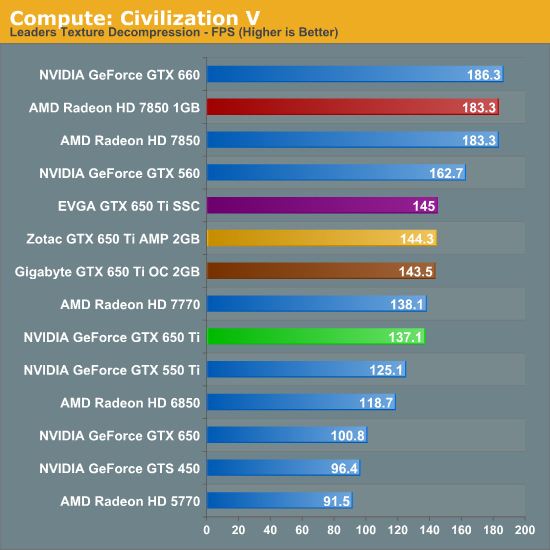
There really isn’t a lot to say here. The GTX 650 Ti is only slightly ahead of the GTX 550 Ti, never mind the GTX 560. Worse, it’s tied with the 7770 and well behind the 7850. Given the nature of the test, with cards on memory busses this small I believe we’ve run into a proxy test for memory bandwidth rather than compute throughput. Which just goes to show that all of that compute throughput is meaningless without the memory bandwidth and cache to feed the best.
Our next benchmark is SmallLuxGPU, the GPU ray tracing branch of the open source LuxRender renderer. We’re now using a development build from the version 2.0 branch, and we’ve moved on to a more complex scene that hopefully will provide a greater challenge to our GPUs.
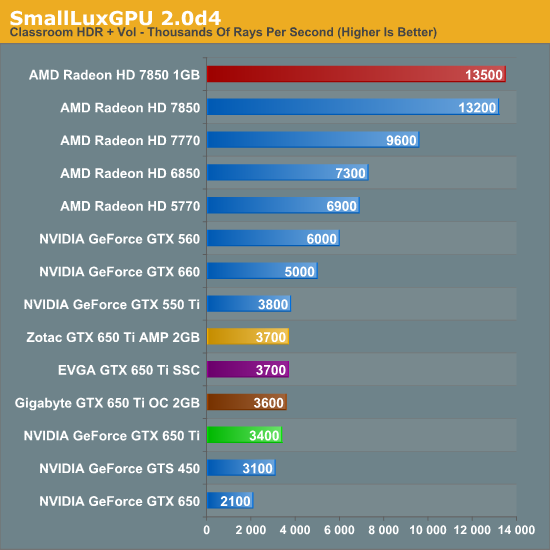
Not surprisingly, the GTX 650 Ti loses to just about everything. SmallLuxGPU’s OpenCL renderer just doesn’t mesh well with Kepler and NVIDIA’s drivers. The resulting lead for the 7850 is nothing short of massive.
For our next benchmark we’re looking at AESEncryptDecrypt, an OpenCL AES encryption routine that AES encrypts/decrypts an 8K x 8K pixel square image file. The results of this benchmark are the average time to encrypt the image over a number of iterations of the AES cypher.
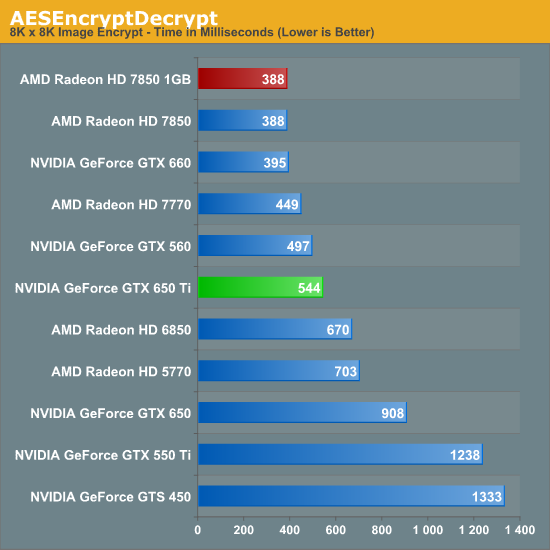
Unlike our previous OpenCL benchmark the GTX 650 Ti’s showing isn’t nearly as bad, but neither is it great. Both the GTX 560 and the 7770 are in the lead, but at least the improvement over the GTX 550 Ti is nothing short of amazing. At times NVIDIA’s problem isn’t where GTX 650 Ti is compared to last-generation cards, but rather it is compared to AMD’s strong Radeon HD 7000 series lineup.
Our fourth benchmark is once again looking at compute shader performance, this time through the Fluid simulation sample in the DirectX SDK. This program simulates the motion and interactions of a 16k particle fluid using a compute shader, with a choice of several different algorithms. In this case we’re using an (O)n^2 nearest neighbor method that is optimized by using shared memory to cache data.
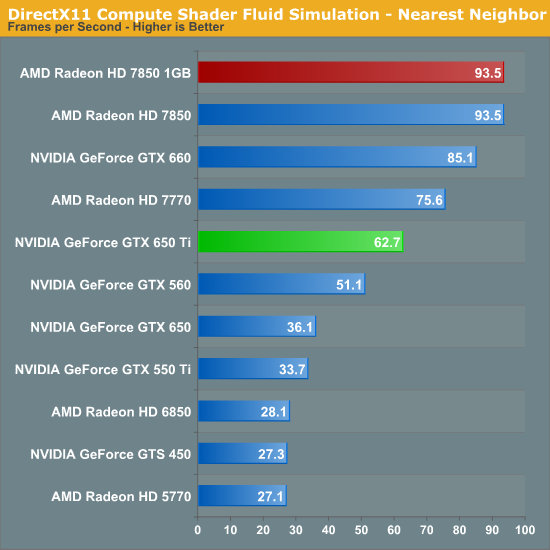
Once more the GTX 650 Ti is in trouble. It can beat the GeForce 500 series, but even the 7770 is faster.
Finally, we’ll take a look at one last benchmark to our compute run with the benchmarkable version of the Folding@Home client. Folding@Home and similar initiatives are still one of the most popular consumer compute workloads, so it’s something NVIDIA wants their GPUs to do well at.
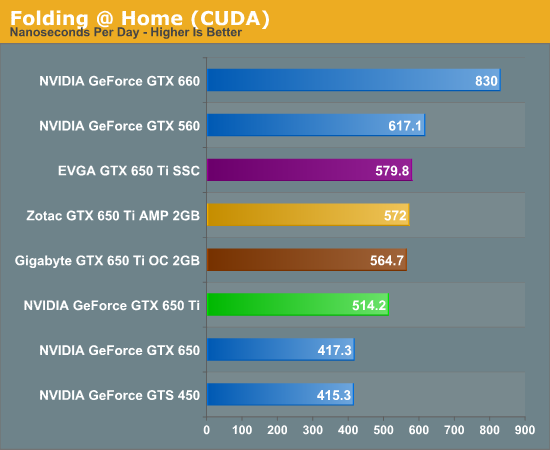
Here’s another case where memory bandwidth and L2 cache appear to be a problem. The GTX 650 Ti is much farther behind the GTX 660 than we would have expected, and even the GTX 560 can take a lead here. On the other hand memory bandwidth bottlenecking isn’t so bad that EVGA’s GTX 650 Ti can’t still take the lead over the other factory overclocked cards.










91 Comments
View All Comments
CeriseCogburn - Friday, October 12, 2012 - link
Oh there's the amd fanboy bloviating spew I predicted above you responded to ! LOL I cannot frikkin believe it, I got it exactly correct without looking ! Here I will FTFamd fanboy" Don't forget, the 650Ti comes with a game and so does the 560Ti. Coming with a game is necessary just to compete right now. The 460 also has some highly factory overclocked models that can smash out the 7770 while still being cheaper. The 7850 would do better at $10 or $20 lower and a MIR is a great way to accomplish that since a lot of people forget to do them anyway, but buy the card because of the after MIR price. ( I love ripoff MIR because I am an idiot shining on for corpo pig profits I hate so much).
ionis - Wednesday, October 10, 2012 - link
2 of the 17 2GB 7850s on newegg comes with a game. I didn't bother checking the 1GB, b/c who cares about the 1GB? To say they comes with a game is a bit disingenuous.CeriseCogburn - Friday, October 12, 2012 - link
It's okay all the amd fanboys can get the lowest low down 1GB now at the cited lowdown more expensive price, that doesn't matter when they are making their arguments for amd fanboyism.Two seconds later they will be screaming the 7850 is future proof with 2g ram so F orget the 650Ti, it is also the best deal againbecause amd roxxors.
So 1gb price, and magically in the deranged gourd of the amd fanboy 2G card is futureproof.
That is the amd fanboy brain after it exited the blender 20 years ago.
Galidou - Saturday, October 13, 2012 - link
The 7850 is a better choice for one freaking big reason you Cerise wouldn't be able to see because you're blinded with green glasses. When you buy a 7850 you always have the choice to go crossfire in the future which is something that happens often in the enthusiast world.Usually GTX is branded for the enthusiast market and reffered as the better cards from Nvidia but hey, where is my SLI connector? Oh... there's none... they had to cut it for cost purposes, that's what Nvidia claims..... First time in history a GTX card comes without one... you're so stubborn you can't even see any downside when they're OBVIOUS..... HELL even half of the radeon 7770 comes with Crossfire support and some of them costs 120$...
nathanddrews - Tuesday, October 9, 2012 - link
I see what you did there...Denithor - Tuesday, October 9, 2012 - link
I caught that too. Thought it was cute but kinda silly.Wonder how much of the target audience got it?
Exodite - Tuesday, October 9, 2012 - link
I'd wager most of the AT readers passed middle school chemistry. :PPaulman - Wednesday, October 10, 2012 - link
Exodite is right. Also, nerds love memorizing trivia (and the periodic table definitely counts).CeriseCogburn - Friday, October 12, 2012 - link
I'll wager if that's minimally true we've got a dumber group than the general populace.Since the idiots group think yours was a great line, the above may in fact be the case.
chizow - Tuesday, October 9, 2012 - link
As indicated in the review, the 650Ti fills the huge gap in performance between the 7850/GTX 660 and 7770/GTX 650, its price just needs to be adjusted in light of AMD's pre-emptive cuts on the 7850. Once we start seeing ~$20 rebates similar to those we see for the 7850, the 650Ti should be a more appealing option in the sub-$150 range.I also think Nvidia missed an opportunity here by turning off Boost for sub-660 parts. It's just inconsistent with the rest of the Kepler line and while it allows partners to benefit on OC parts, they are clearly charging an additional premium instead of offering it at MSRP like past parts such as EVGA FPB.
Most interesting to me seeing how these bandwidth neutered parts perform is how shading/backend performance has caught up and is generally no longer the biggest bottleneck; bandwidth tends to hold these cards back more often than not compared to their bigger siblings even at modest resolutions like 1080p.